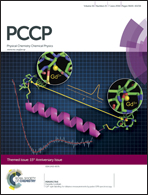Electronic structure of positive and negative polarons in functionalized dithienylthiazolo[5,4-d]thiazoles: a combined EPR and DFT study†
Abstract
2,5-Dithienylthiazolo[5,4-d]thiazole (DTTzTz) derivatives have high potential for solution-processed organic field-effect transistors and solar cells, both as electron acceptors and donors. Here, the electronic structure of positive and negative radicals (polarons) of two functionalized DTTzTz materials is studied using multi-frequency and multi-resonance electron paramagnetic resonance (EPR) in combination with density functional theory (DFT). It is shown that the negative and positive DTTzTz polarons can be distinguished on the basis of their characteristic EPR parameters. The chemically induced polarons are compared to light-generated states observed in a blend of one of the DTTzTz derivatives with a donor polymer. The study gives in-depth information about the spread of the electron or hole in the DTTzTz molecules.
![Graphical abstract: Electronic structure of positive and negative polarons in functionalized dithienylthiazolo[5,4-d]thiazoles: a combined EPR and DFT study](/en/Image/Get?imageInfo.ImageType=GA&imageInfo.ImageIdentifier.ManuscriptID=C3CP54635G&imageInfo.ImageIdentifier.Year=2014)
- This article is part of the themed collection: PCCP’s 15th anniversary

 Please wait while we load your content...
Please wait while we load your content...